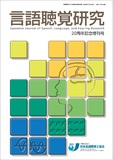Japanese
English
- 有料閲覧
- Abstract 文献概要
- 1ページ目 Look Inside
- 参考文献 Reference
【目的】本研究の目的は,わが国における小児聴覚障害に対する言語聴覚療法のエビデンスをシステマティックレビューによってまとめ,今後の臨床,研究に役立てることである.リサーチ疑問は「わが国の小児聴覚障害に対する言語聴覚療法はどのようなアウトカムを示しているか」であった.
【方法】適格基準を設定し,検索語/検索式を明確にして文献を検索・選択し,1次・2次スクリーニングを実施した.採択された研究についてバイアスリスクなどを評価し結果を質的に統合した.
【結果】1次・2次スクリーニングを経て1,003編中43編の文献が採択され,研究デザインは横断研究2編,症例対照研究15編,単一事例研究デザイン9編,症例集積17編であった.指導内容は,聴覚口話法,文字音声法,親子関係の指導などであり,各指導法で,言語性IQ,読書力などで正常範囲以上の効果を示す報告もみられた.0〜1歳代の1例ケーススタディでは,象徴機能,コミュニケーション,遊びの発達などによる効果が報告された.
【考察】各方法による指導・支援の結果,聴覚障害乳幼児が年齢相応の言語力を獲得したことが示された.しかし,指導法による差などを直接比較した研究は存在しなかった.今後,評価尺度・指標の共有などが進み,質の高い研究が増加することが望まれる.
Objective:The purpose of this study is to compile evidence on the effectiveness of speech-language-hearing therapy for children with hearing impairments in Japan through a systematic review, and thus to contribute to future clinical practice and research. The research question was, “What outcomes does speech-language-hearing therapy demonstrate for children with hearing impairments in Japan?”
Methods:After establishing eligibility criteria and clearly defining search terms and expressions to search and select relevant articles, the primary and secondary screenings were conducted. Then the risks of bias and other factors were evaluated for the selected studies, and the results were synthesized qualitatively.
Results:After the primary and secondary screenings, 43 out of 1,003 articles were selected. The study designs included 2 cross-sectional studies, 15 case-control studies, 9 single-case study designs, and 17 case collections. The intervention content included auditory-oral method, written-oral language method, and parent-child relationship guidance. In each method, there were reports of cases reaching above the normal range in areas such as verbal IQ and reading ability. A case report of a child aged 0 to 1 year reported positive effects on symbolic functions, communication, and play development.
Discussion:The results of intervention and support through each method showed that infants and toddlers with hearing impairments acquired age-appropriate language skills. However, no studies directly compared the difference of effectiveness among the methods of intervention. It is expected that future research will share the same evaluation scales and metrics, leading to an increase in high-quality studies.

Copyright © 2025, Japanese Association of Speech-Language-Hearing Therapists. All rights reserved.


